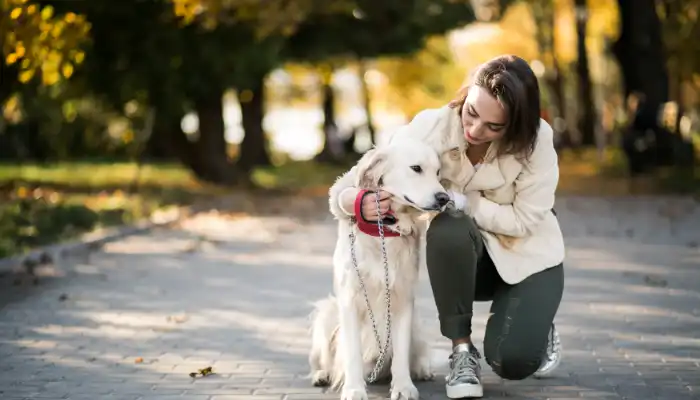Considering the concept of leaving and departure, one thinks about how our friendly animals convey their feelings. How do dogs say “goodbye”? That is a question that almost every owner of a pet has been asking for many years. While dogs do not communicate using human language, they can convey their message in other ways.
Recognizing these signs is essential in order to gauge how a dog feels. A Dog Translator, in other words, would assist us in deciphering the faint clues they give when it is time to separate. For now, let us examine How Do Dogs Say “Goodbye”, Their Way.

The Body Language of Dogs
Dogs engage and express their feelings or thoughts through different forms of body movements. When it comes to parting, their posture, gestures, and even the movements on their face might be telling a different thing altogether. But how do dogs say “goodbye” through their body movements? Let’s break it down further:
Key Signs of Goodbye Through Body Language
- Tail Wagging: While dogs wag their tail for many reasons, the way of doing it can suggest a lot about their feelings. A Thousand One Tales contains an emotional component. A Matted Set of Gain reflects Great Western Mortar Syndrome. Wags a bit slowed down together with dropping body do suggest aloofness or sadness.
- Avoiding Eye Contact: When your dog seems to ignore your gaze while you are leaving the house, it may be their way of letting you know that they do not want to part.
- Sitting Down and Looking Away: Some dogs will sit or lie down and turn away from you as if to show that they are accepting the separation, albeit reluctantly.
- Pawing: Dogs sometimes raise a front paw as they tap or lightly hit you, which may mean they want to show slow affection or be a non-blunt way of requesting you can stay.
- Nose Nuzzling: A nuzzle with the nose or sniff is yet another way to express some form of desire which further indicates that the dog wishes to stay near you.
By recognizing and understanding these signs, you can make sense of how dogs bid farewell to humans. All these behavior signals will be manifested in different forms in different dogs, but the feelings that create those signals are more or less the same.
Vocalizations and Sounds
Dogs are particularly vocal in different manners to indicate their feelings. But just How Do Dogs Say “Goodbye” in sounds? While some dogs may unleash happy barking sounds upon seeing you, they will surely use other vocal sounds to signify it’s time for you to exit.
Typical Goodbye Vocalizations
- Whimpering/Whining: Dogs whine to express discomfort or sadness. If a dog starts to whine when you walk toward the door, it is a means of saying goodbye in a more touching manner.
- Soft Growls: Even though growling usually has negative implications, a light growl or murmuring can signify frustration or longing, meaning that the dog does not want you to go.
- Barking at the Door: Some dogs love barking, and this can be particularly evident when they sense someone is about to leave. In such cases, they will bark uncontrollably at the door, showing their anger.
- Howling: Certain breeds, such as Huskies, are more vocal than others. If your dog howls as you leave, it’s likely their way of saying goodbye.
Ultimately, dogs restrain themselves from saying goodbye through vocalizations, be it whining, howling, or even just softly growling. These sounds represent their emotional means of saying goodbye to you.
The Importance of Routine and Farewell Rituals
Dogs are creatures of habit and patterns make them feel at ease. But How Do Dogs Say “Goodbye” when their master’s schedule changes or when there is some sort of abrupt departure?
How Dogs Handle Scheduled Departures
- Familiar Goodbye Customs: Some dogs may be able to pick up specific patterns that relate to your departure. For example, they may have learned that when you grab your keys or put on shoes, you are about to leave. They would logically say goodbye by resting near the door or giving you a slight nudge prior to your departure.
- Separation Anxiety: In cases of separation anxiety, dogs might express their goodbye through pacing, drooling, or destructive behaviors such as chewing things. Ultimately, it is their way of showing how much they dread being separated.
- Extended Goodbyes: Other dogs will try to postpone saying goodbye, by shadowing you as you prepare to leave. They want to be present until the last moment.
Any abrupt shift in your schedule could throw your dog off balance. Nevertheless, in these cases too, their approach toward goodbyes usually involves seeking some kind of spatial closeness to you or requires affirmation from you.
Emotional Bonding and Saying Goodbye
Dogs are emotional beings, and their connection with you can be deeper than what you imagine. So, how do dogs bid farewell to people they have grown a strong emotional attachment to? Let’s find out.
Signs of Emotional Goodbye
- Snugging or Cuddling: One of the ways your pet might bid farewell is to snuggle with you before you step out of the house.
- Looking Sad or Withdrawn: The dog might just stare quietly at their owner and in essence act a little sadder and withdrawn than they normally would.
- Following You Around: Your dog may be more attached to you than you think if he or she follows you around the house or to the garage. This indicates some reluctance to part ways, and instead willingness to stick by your side.
Goodbyes, particularly emotional ones, tend to be very subtle but are packed with meaning. Dogs may not show emotions very vividly, but you can be sure their actions speak of the emotional burden of separation.
Conclusion
Therefore, How Do Dogs Say “Goodbye”? The answer is it is a combination of sounds, body action, and emotional attachment. Though they do not have a vocabulary, their actions tell everything. Dogs exhibit their sadness to say goodbye in manners that depict strong affection.
By watching how they act, we can make the experience of separation less painful and more comfortable for them. Although wishing for a Dog Translator is tempting, the heartwarming pets and the distinctive ways they express goodbye are sufficient enough for us to know how much they cherish us.
